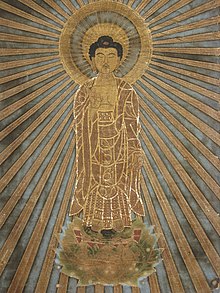Other power

Other power (Chinese: tālì 他力, Japanese: tariki) is an East Asian Mahayana Buddhist concept which is discussed in Pure Land Buddhism and other forms of East Asian Buddhism. It generally refers to the power of a Buddha which can inspire someone, and take them to the Pure Land where one may easily become a Buddha. Other power is often contrasted with "self power" or jiriki (自力, one's own strength[1]), that is, attempting to achieve enlightenment through one's own efforts.[2]
Pure Land Buddhism considers itself the easy path that relies on other power, while other Buddhist paths are seen as self power paths, also called "the path of sages".[3] While all Mahayana Buddhists agree that the Buddha's power has some effect on Buddhist practitioners, the various Mahayana Buddhist traditions have different accounts of how the other power of the Buddha works and how one's own practice interacts with it. Some Pure Land Buddhists hold that we must abandon all "self power" practices (such as ascetic practices, repentance, various kinds of meditation) and all self effort, and rely only on Amitabha Buddha's other power. Others hold that one's own "self power" becomes linked with the power of the Buddha through "sympathetic resonance" (gǎnyìng 感應). This view of the cooperation of self power and other power is more common in Chinese Pure Land thought.[4]
Tibetan Buddhism also affirms that there are multiple causes to rebirth in a Pure Land, and that both the Buddha's power and the power of one's own karmic force are contributing causes.[5]
Indian precedent
[edit]There are various Sanskrit concepts found in the Mahayana sutras that are precedents to the East Asian concept of "other power", including:
- Buddhānubhāva - This term refers to the "majesty", "authority, or "causal power" (anubhāva) of the Buddha which can influence others. In numerous Mahayana Sutras (e.g. Prajñaparamita sutra), the Buddha's disciples are often depicted as speaking or teaching "through the Buddha's power".
- Buddhādhiṣṭhāna - Refers to the "sustaining power" or "supporting force" (ādhiṣṭhāna) of the Buddha, often associated with his ability to inspire or bless beings.
- Buddha-bala - This term literally means "the strength of the Buddha," where *bala* refers to the Buddha's strength or power, or more specifically, to special supranormal powers the Buddha has which he uses to perform miracles.
- Buddhāvabhāsa - Meaning the "radiance" or "light" of the Buddha, this term is sometimes used to signify his illuminating power or his wisdom (which in various Mahayana sources, like the Avatamsaka Sutra, is said to be all pervasive).
See also
[edit]- Glossary of Japanese Buddhism
- Synergism and monergism, comparable ideas in Christian theology
References
[edit]- ^ Kenkyusha's New Japanese-English Dictionary, Kenkyusha Limited, ISBN 4-7674-2015-6
- ^ Hiroyuki, Itsuki (2001). Tariki: Embracing Despair, Discovering Peace. New York: Kodansha. p. xvi. ISBN 978-4062099813.
- ^ Bloom, Alfred (1964). Shinran's Philosophy of Salvation By Absolute Other Power, Contemporary Religions in Japan 5 (2), 119-142
- ^ Jones, Charles B. (2021). Pure Land: History, Tradition, and Practice, pp. 165-188. Shambhala Publications, ISBN 978-1-61180-890-2.
- ^ Halkias, Georgios T. (2012). Luminous Bliss: A Religious History of Pure Land Literature in Tibet, p. 123. University of Hawaii Press.
Further reading
[edit]- Bein, Steve. (2008, January). Self Power, Other Power, and Non-dualism in Japanese Buddhism. In Proceedings of the XXII World Congress of Philosophy (Vol. 6, pp. 7-13).
- Ford, James L. (2002). Jōkei and the Rhetoric of "Other-Power" and "Easy Practice" in Medieval Japanese Buddhism, Japanese Journal of Religious Studies 29 (1-2), 67-106
- Furuta, Shokin. (1990). jiriki (Self-power) and tariki (Other-power). Journal of Indian and Buddhist Studies (Indogaku Bukkyogaku Kenkyu), 39(1), 170-178.
- Harding, John S. (2008). "Bodily crisis and religious conviction: Implications of Kiyozawa Manshi's illness". Studies in Religion/Sciences Religieuses. 37 (2). SAGE Publications: 211–233. doi:10.1177/000842980803700202. ISSN 0008-4298. S2CID 143603681.
- Ingram, Paul O. (1973). The Zen Critique of Pure Land Buddhism. Journal of the American Academy of Religion, 41(2), 184-200.
- Ingram, Paul O. (1968). Hōnen's and Shinran's Justification for Their Doctrine of Salvation by Faith through "Other Power", Contemporary Religions in Japan 9(3), 233-251
